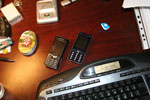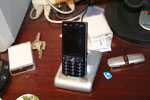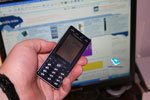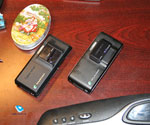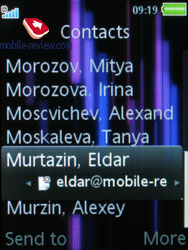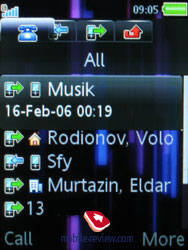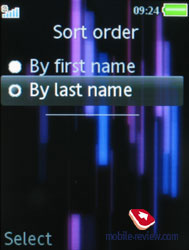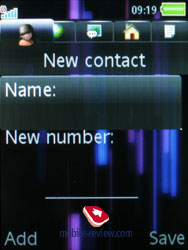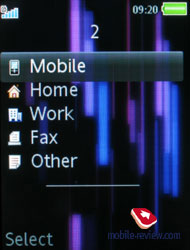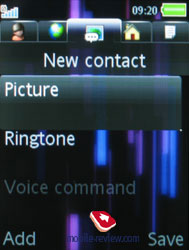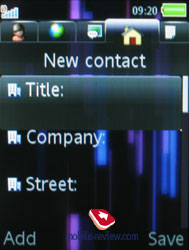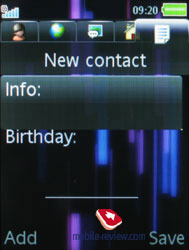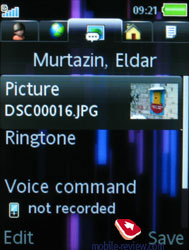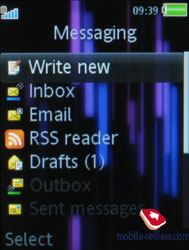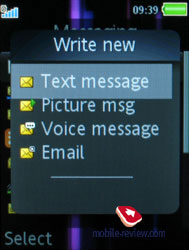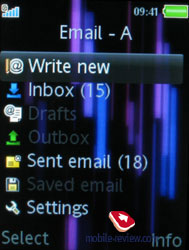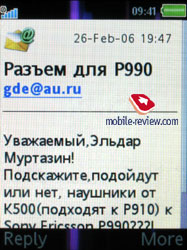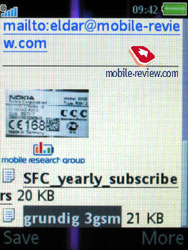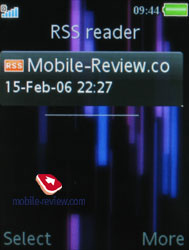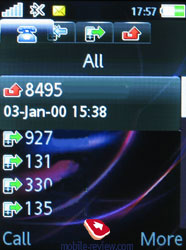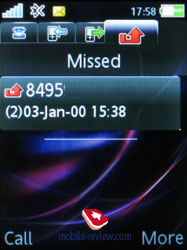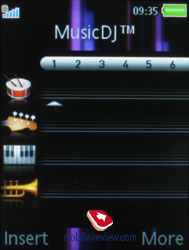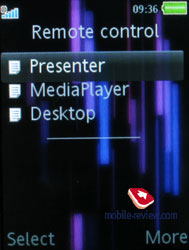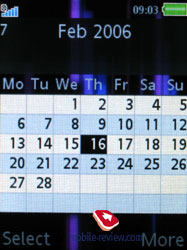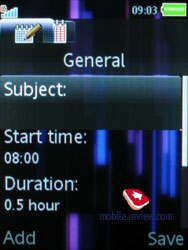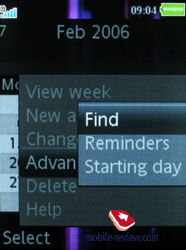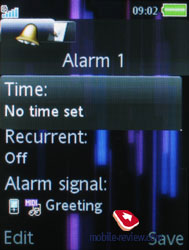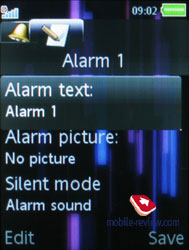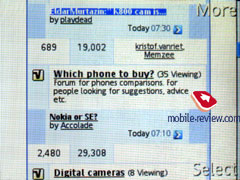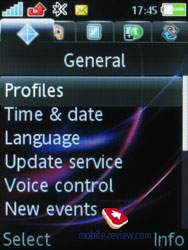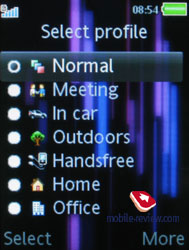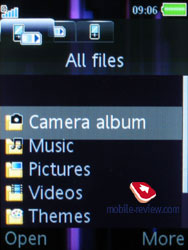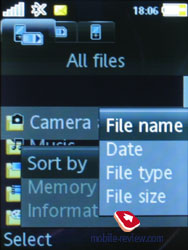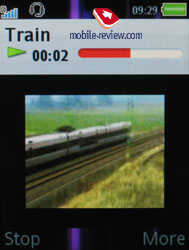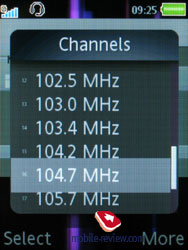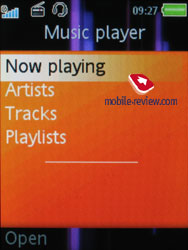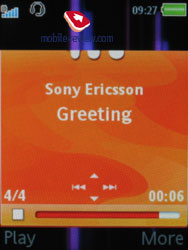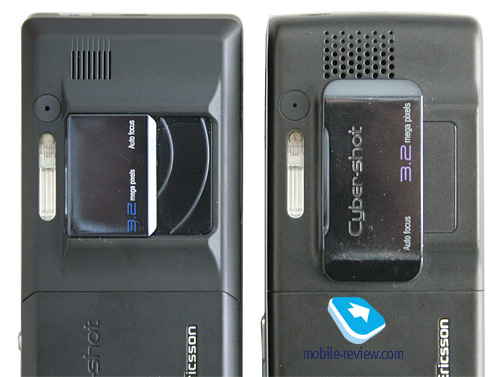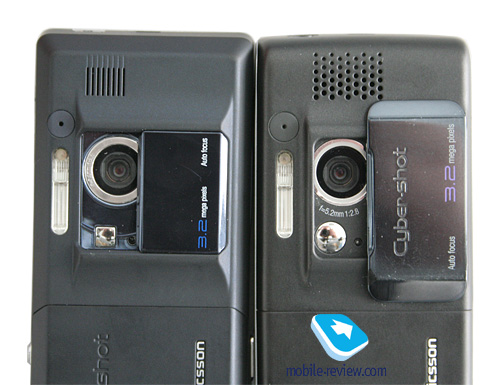|
|
Review of GSM/UMTS-handset Sony Ericsson K810i
Live photos of Sony Ericsson K810i
Inauguration of the company’s new flagship, namely Sony Ericsson K810i, was accompanies by tons of sharp criticism, and the reasons for that were many. How come, while competitors are releasing 5 Mpix-armed models, we are presented with the same product yet in different wrapping. What kind of flagship is this, when it doesn’t improve upon its predecessor, Sony Ericsson K800i, in any substantial aspect? In fact, it would seem, everything looked exactly this way, for the people who had already purchased Sony Ericsson K790i/K800i, going for the latest-and-greatest offering didn’t make any sense to them, however this device is not meant for them. This actually the first model enjoying the new line-up expansion who Sony Ericsson, when already known products receive fashion and emotional boost. And this is how it turns out: on the one hand the handset is pretty familiar, though on the other side, everyone is free to pick the most fitting edition without sacrificing any of the device’s functionalities. This approach is also characteristic for Nokia, who invented it in 2002 and then other vendors ripped it from them. In the year of 2007 up to one third of all new products are going to employ this idea: slight modifications leading to new positioning. Instantly, such duos as Sony Ericsson K550i/W610i, Sony Ericsson W610i/W660i will spring in everybody’s minds for sure.
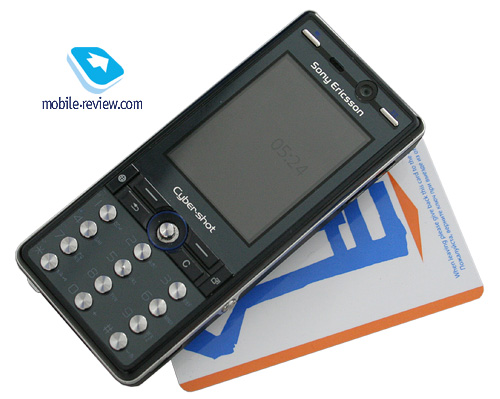
Sony Ericsson K810i is designed after the K800i, being almost an exact replica of the latter, yet houses enough of “tiny” alterations, lending it a somewhat different feel. The first thing that grabs your eyes is the number pad, whose buttons are rounded with concentric texture. It does make you believe that it is nothing else but metal; up until now keys with such shapes were used only in Mobiado’s handsets, which are in fact tuned and revamped editions of Nokia’s commercial products.


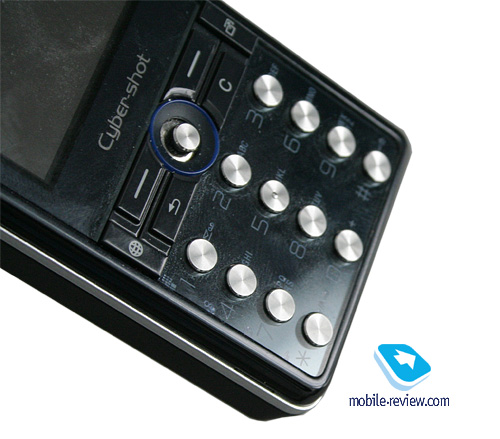
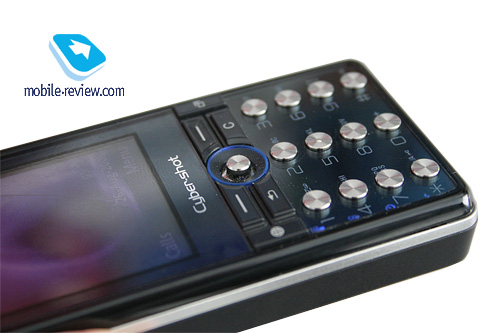

The numeric buttons are easy to use, boast soft travel, so their form and spacing seem to be well-matched after all. Since the keys themselves could not possible have backlighting, the key padding, the front panel itself glows with blue. The front fascia is made of transparent plastic, unlike the K800i’s metal, underneath lays inky sub-layer. There is also another trim available, to be more specific, silver, but both look good.
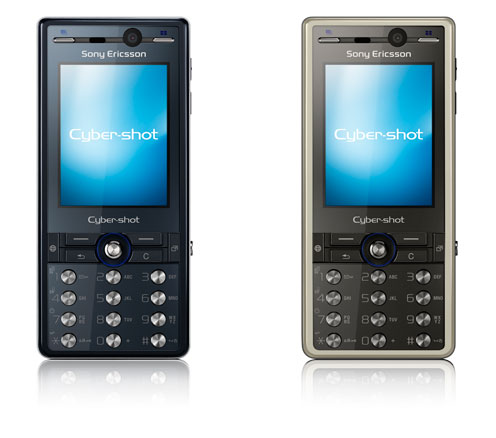
The handset’s style, thanks to the plastic used, is closing in on what we see on the company’s now-current solutions, like Sony Ericsson Z610i, Sony Ericsson W610i. At that the plastic on the sides and the rear is still finished in soft-touch, yet inky as well as well (in our unit).
The functional keys above the display have grown in size and ease-of-use aspect, and what’s more there are now captions on the casing standing for what they do. The socket of the main speaker has been cut down and now lacks metal grill, which makes it less appealing in some respect, but again, it is all about Sony Ericsson K800i’s being made of metal, while the K810i is more staid, fashion-charged. It seemed to me that during a call the K810i was harder to line up with my ear properly, since the sound was sometime muffled due to a grill like that.
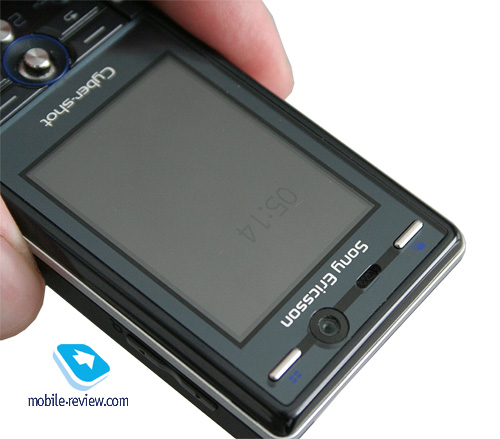
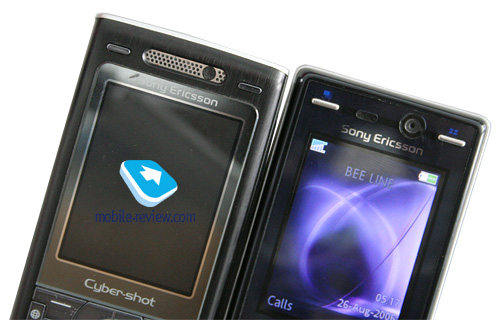
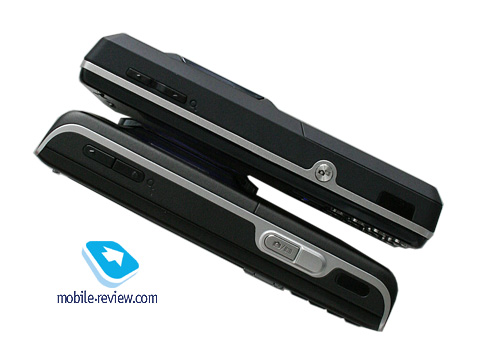
The plastic used on the front plate makes for easier-to-soil surface, as it readily picks up face grease and fingerprints. From the practicality standpoint, the K810i is obviously behind Sony Ericsson K800i.
While having the same functionality to the last bit, the revamped model has got one millimeter trimmed from the casing’s thickness, thanks to its different camera shutter, which is now recessed into the casing, thus opening it accidentally when carrying the K810i in pocket is next to impossible. In this regard the handset looks interesting. For the rest of its physical data, the phone weighs in at 115 grams, and shaves 2 millimeters off the predecessor’s length, which allows it to measure only 104x46x17 mm.
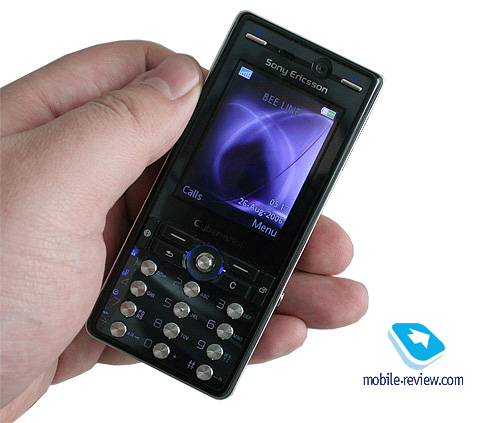
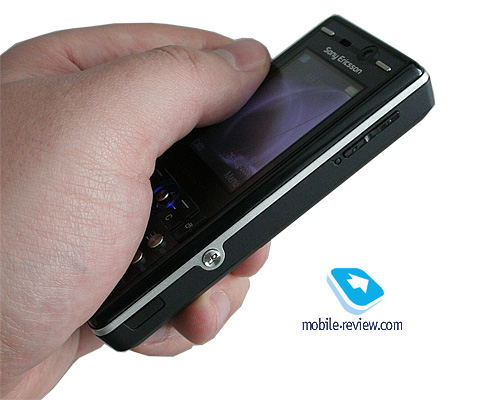
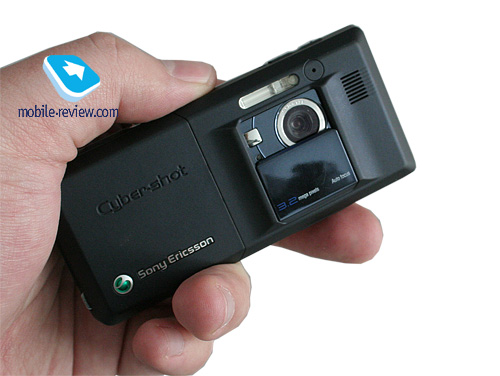
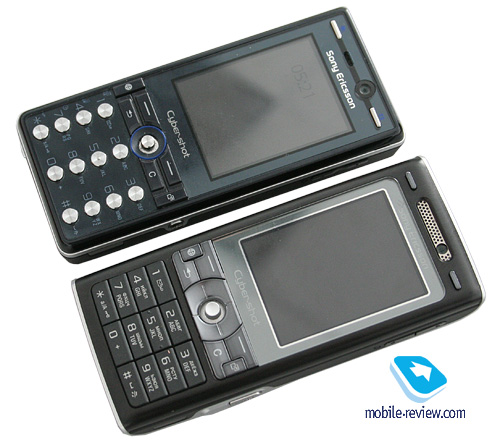
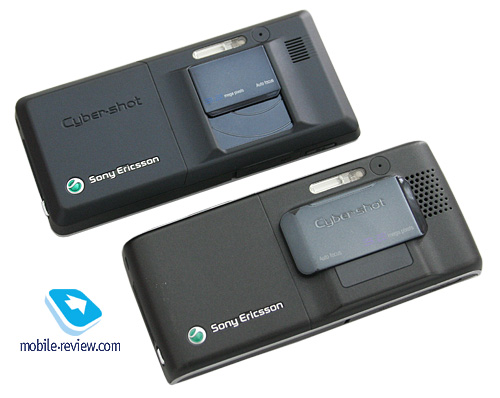

The display hasn’t undergone any updates, matching that of the previous model. Even though it is pretty crisp, the K810’s screen still can’t reach Motorola ROKR Z6 in this aspect, though is in line with solutions put up by other vendors like Samsung and Nokia. The display shows up to 262 K colors at 240x320 pixel resolution, which allows accommodating up to 8 text and 3 service lines for most applications; and when browsing web-pages, or handling e-mails or text messages, you can cram more lines into the display by decreasing the font size.
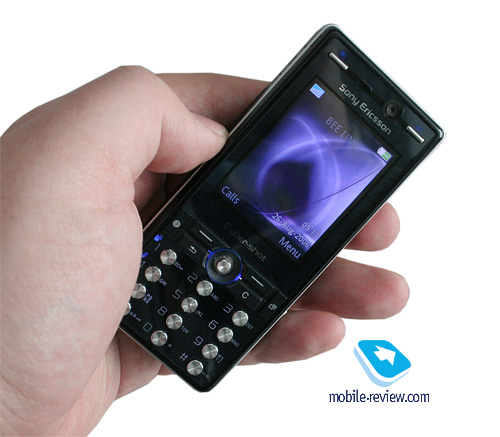
The lower end plays host to the standard interface socket Fast Port, used for plugging in headsets and data cable. Here you will also find the holes for a carrying strap. The top end traditionally features the power button, doubling as profile switch in standby mode.
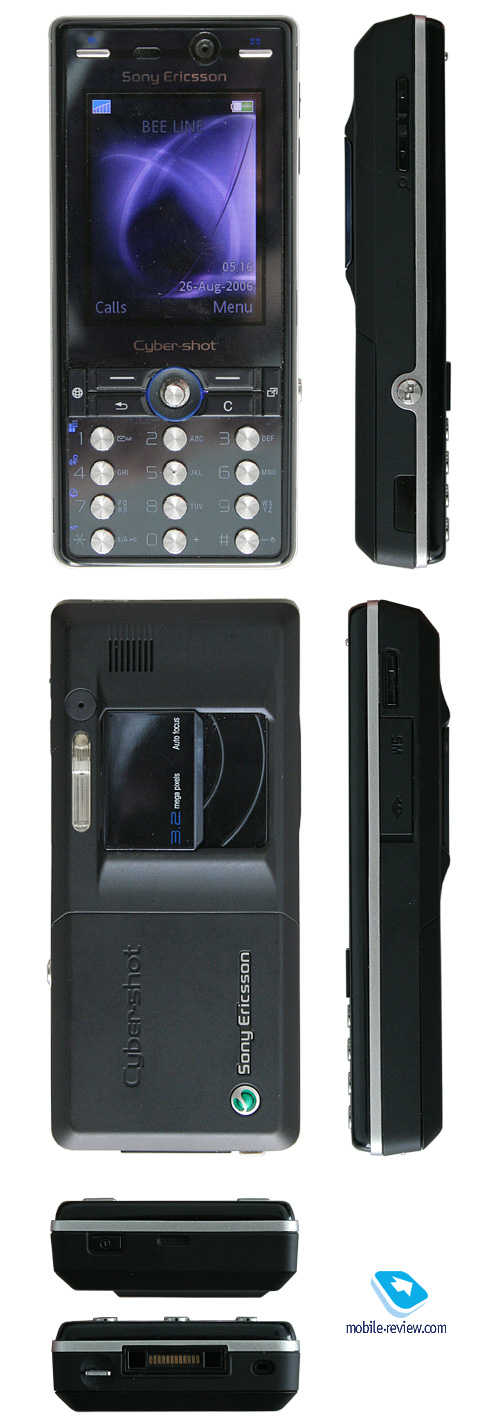
Flipping over to the phone's right side, the Infrared window can be found, as well as the volume rocker and dedicated camera key. Such layout, that has already become par for the course for most of the company’s offerings, is due to landscape orientation of the phone when working in camera mode.
Looking at the left-hand side reveals the music button, that can be set up to launch the radio, player or the last used application. Further down is Memory Stick M2 memory expansion slot.
The handset utilizes a 900 mAh Li-Pol battery (BST-33), that is starting to be a constant guest on all of Sony Ericsson’s latest proposals, including medium-priced ones. As the manufacturer claims, it can keep the handset up and running for 350 hours in standby, and provide up to 2,5 hours of talk time within UMTS networks, and up to 7,5 hours for GSM.
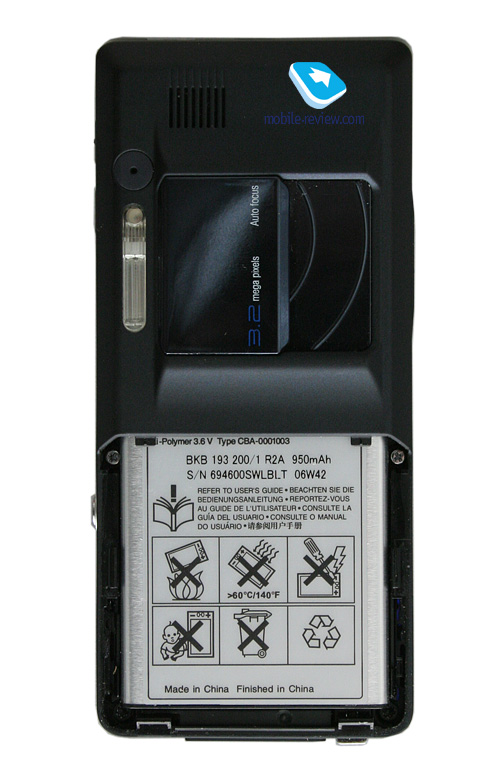
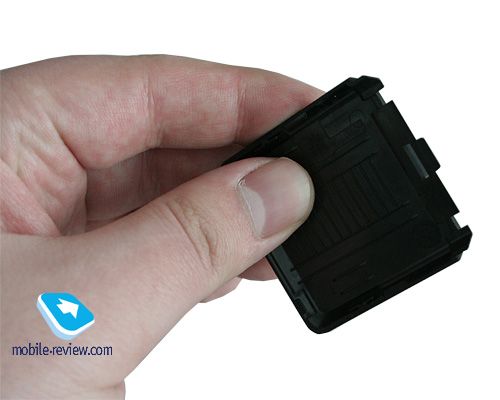
Those planning to have music playing in wireless headphones, ICQ running in background, take snaps, check mail every two hours should get ready to recharge the K810i daily; its take the phone almost 2 hours to charge up from empty to full. At the same time, normal usage mode with an hour of calls, 10-12 messages a day and occasional mail checks results in a solid two-day lifetime (for Moscow networks). The European networks, sporting better coverage, will boost the battery life a little.
Menu
The main menu pops up before you as a grid consisting of 12 icons. Shortcut number navigation is on the K810i’s spec sheet as well – you can assign shortcuts to most menu items, that the handset comes pre-installed with, whereas own applications or files can’t be set up for one-touch access.
Text input has remained on the same comfort level, so, pressing the "#" key brings out a list of the available languages and you can easily switch between them while typing.
Besides traditional vertically arranged sub-menus, the maker has provided subject-based horizontal tabs. It means that while viewing a list of the dialed numbers, one can see not only the dialed numbers but in the same time (by leaning the joystick horizontally) switch between missed and received call tabs. In the phone menu this kind of navigation is provided anywhere it's possible and it makes for much better usage experience. The menu ergonomics is quite high in this phone. I also have to note that such horizontal tabs appear in Phonebook, Settings and other menu items as well.
Much like the K790i, the Activity Menu contains four tabs. The first three ones display various events, like missed calls, memos, messages – actually all this can be found in the first tab. One can disable Activity Menu for these events as well – in this case pop up windows, reminding of a certain event type will appear on the screen. The third tab features the shortcuts, which you should set up yourself. And the added fourth one contains links to the most frequently used applications and resources – and the top of this list is claimed by Google search. The second tab is the most interesting, since it appears to be some kind of a task manager, featuring the list of all currently running applications. User is able to have up to eight Java-applications launched (in fact there are no severe caps, yet the RAM cannot bear more than 8) simultaneously and switch between them. This may come in handy, in case you use an ICQ-esque mobile client, which should be constantly online, and at the same time want to play a Java-game. Up to now counterparts of this solution by other manufacturers haven't been announced.
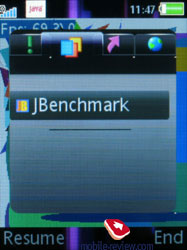
On USB-connection you are forced to pick connection type – specifically whether you will be accessing data stored on the memory card or just keep managing the phone or activate Print mode. For the first mode we mentioned above the handset goes off and you gain access to the contents of both the memory card and the phone internal memory. Despite the maker claiming it to be USB 2.0, data transfer speed doesn’t exceed 500 Kb/s. If you just want your K810i to turn into a modem, then pick the second option, when you will have a chance to play around with various USB settings for going online.
Phonebook. Up to 1000 contacts with fully filled in fields can be stored in the phonebook, but number of phone numbers is limited to 2500. This means that despite the ability to assign up to 5 phone numbers to one contact, you cannot go over 2500 entries. This is enough even for the most active users, as only few have more than 500 entries in their phonebooks.
As mentioned above, several phone numbers can be submitted for one contact, as well as address, email, IM number, other contact information. In settings you can select the required fields, they will be available, meanwhile the useless ones will not be presented. Contacts can be sorted by fields, including name and surname, but only one input field. Unlike previous models, this time we have dynamics on - handset automatically sorts the list after changes.
It is possible to assign custom ring tone and photo to each contact. On incoming call the image and ring tone will be used. Date of birth field can be synchronized with Organizer, at that you will have a chance to set how many days prior to the event the handset should warn you.
When you are typing in information, you can scroll between tabs, in the first one you enter phone numbers, categorize them by types. On the whole the organization of this process reminds of Outlook, and it means comfort in the first place. Voice tags can be added for required phone numbers, names, there can be up to 40 of them. Voice dialing remained the way it was many months ago, it starts looking archaic with all these voice independent recognition software being implemented by the competitors.
The company still follows its traditional beliefs that SIM-card is used only in case of emergency, that’s why the only way to see its contents is to go into special option in the menu. SIM contacts are not displayed in the general list.
You can create a back-up copy of all entries in phonebook, which will be stored on the memory card, so that you will have the ability to restore them afterwards.
Contact Groups serve only for mass SMS sending, since it is impossible to bind custom ringtone or photo for Group.
Any video clip may be used as caller ID for any entry in the phonebook
Messaging. All tools used for managing messages are standard, there are some templates available and you can come up with some more of your own. Phone’s memory together with SIM-card is used for storing messages. Chat function is supported. On the whole everything is just like in any other phone from this company.
The MMS implementation is as always great, you can literally create video clips, there are lots of settings and this is one of those things that give SE’s product a cutting edge over competitors.
E-Mail client can send and receive e-mails, all sorts of encodings are supported. The emails can be stored on memory card.
In email settings you can setup separate password for SMTP-accounts, this is very convenient. The settings are flexible, support for almost all encodings, and not only Unicode has been added. Attachments that are supported by the phone are presented as icons in an email’s body. The phone doesn’t recognize office files or PDF, but they can be stored in any directory. The limit for outgoing/incoming email size is set by operator. Emails with 6-7 Mb attachments can be sent without any hassles. The phone supports Push Mail standard. Naturally send & receive process is carried out in background mode.
RSS Feed. The settings for this item are really simple - you just specify the title for feed and its address. The phone will connect and download it without your assistance. You can update only one item, or the whole feed at once. Capabilities of built-in browser are used for displaying the feeds. Feeds may be updated on schedule.
Call list. Up to 30 records can be stored in the general list, all with date and time. Icon that stands for call type (missed/received/dialed) is shown next to each entry. Besides this additional icon identifies if this phone number is present in the phone book or SIM-card. The list of missed calls can be viewed separately and stores up to 10 entries. In this menu you can also see the cost and length of all outgoing calls and last call. Navigating through the lists works with the help of tabs and this does save much time.
Entertainment. Photos, music files can be accessed from this menu. MusicDJ function is rather interesting, even though it is a niche solution and there is not much of a chance that this feature will be highly demanded. In the editor you can create ring tones and edit up to four bands.
Advanced version of MusicDJ is called VideoDJ, it allows editing not only music files, but also adding images and signs. The resulting file is recorded in .3GP file which can be sent by MMS or Email, or just transferred to another phone.
PhotoDJ has kept the name but had its inners completely revamped. The manufacturer has partly removed the shroud handing over the impending CyberShot projects, which will feature this editor by default. Now tell us, how often do you draw with your handset or create own pictures? The answer for most will be as clear as it only could be – never. At the same time getting rid of red-eyes effect, adjusting a shot’s brightness, contrast, sharpness, overlaying some effects, might well come in handy on certain occasions, but to do that you frequently have to wait the moment when you get photos uploaded to a PC. The new PhotoDJ looks to make performing these most basic actions as easy as it has never been before, enhance the handset with the ability to carry out these operations on the go. This move is definitely a big plus for Sony Ericsson and will be followed by other companies; and Nokia will be in the first rows (such functionality will get to its phones due out in the second half of 2007).
Remote control – ability to control other devices via the phone’s Bluetooth connectivity. It is standard for all phones made by Sony Ericsson
The sound can be recorded by Sound Recorder - it allows making clips that can be later used as ring tones. Phone calls can be recorded too, this is done from context menu, no time limits are set for the Sound Recorder.
Games – the handset plays host only to one game – Tennis.
Organizer. Organizer keeps a lot of functions underneath. Let’s get Calendar out of the way first. There are three view modes embedded in the K810i’s calendar: weekly, monthly and daily. The last option displays the list of all events and memos, in two others you will see highlighted time or day. You can switch to required day and year, or month. So everything is pretty simple, just as the schedule input is. You get the ability to name the event, define the place where it will take place, set length and setup the reminder (before or right at the start of the event). Recurrent events support is also onboard. Types of reoccurrence: daily, monthly, yearly. Reminders work even if the phone is turned off as well, unless you disable this function.
To do list in this phone is quite ascetic. There are only two types of events: phone call and reminder. On the other hand, this is really enough, simplicity has its own advantages.
The phone has full-fledged search, set up for calendar: you specify the search line (word or part of it) and after a while you will see all events that match this criteria. The function is quite speedy even if the organizer has more than 100 entries; fast switch to the event from the search window is supported.
The phone features transfer of schedule to various devices (traditionally via IrDA and Bluetooth). Choose the required interval (day, week or month) and send all entries – it is that simple. I’d like to point out that the device should support PIM function in order to open and display this data properly.
Notes. The phone supports notes entry, though they are limited in length. The name of the note you see on the list will be first word entered. This is not always convenient since you will have to think of the first word that would tell you what the note is all about.
Alarm Clock. Now you have access to five alarm clocks, and each of them can be set up manually. They can work in definite week days. Besides the ring tone for alarm clock you can select small note and picture, they will be displayed when alarm clock goes on. Any sound file can be assigned as the alarm tone.
Stopwatch/Countdown. Here everything is quite standard, although the same can be said of the stopwatch that has intermediate times function. The phone has special application for storing secret codes, which was a huge success in previous models, well, standard calculator is onboard too.
Connectivity. All connectivity settings for the phone can be setup from here, starting from WAP and GPRS (similarly to the K800i, EDGE is missing here,) to Bluetooth and Synchronization. I will not describe the standard options, they are kind of standard in the first place, and everything works fine. I’d like to highlight stable Bluetooth operation - no problems were encountered, synchronization with other devices runs smoothly, all profiles (including A2DP, which is stereo sound via Bluetooth) are supported. EDR-enabled Bluetooth version is 2.0.
Local and Remote synchronization can be setup from the same menu. The phone supports HID profile which allows using it as Remote control for PC and other devices.
The following Bluetooth profiles are supported:
- Dial-up networking profile
- Generic Access profile
- Generic Object Exchange Profile
- Object Push Profile
- Serial Port Profile
- Handsfree Profile
- Headset Profile
- Synchronization Profile
- Basic Imaging Profile
- File Transfer Profile
- HID Profile
- SyncML OBEX binding
- JSR-82 Java API
- A2DP
WAP. The browser owns separate menu item, the version is 2.0, it supports secured connections which is quite important in case you are using electronic transactions. New wallpapers, themes and ring tones can be downloaded right away – all this is available at the original web-site.
Standard browser for Sony Ericsson phones is NetFront, which supports single-column web pages display and HTML. One of the best things about it, is the ability to create folders with files and bookmarks. The browser is considered to be one of the market’s best offerings, but limited phone resources do it no favors. On the whole those using Internet constantly should consider buying PDA or laptop, since full-fledged Internet access is not an ultimate must-have for this device type. At the same time RSS Feeds support is great, it allows using the phone for reading news, announcements and articles on the go in a convenient fashion.
HTML pages that contain advanced formatting or exceed 500kb in their size will not be displayed. On the whole standard browser is all fine, but usage of Opera Mini is preferable, since it has got way more to offer.
Settings. This menu stores all settings related to the phone’s operation. In the stand by mode clock can be displayed at the bottom (on or off), you an also alter the font size, in case you select big letters it will be easy to see what time it is, but the font itself becomes a tad transparent. There isn’t anything to add, all the rest is standard.
The themes enable you not only to alter interface design, but the main menu looks as well.
File manager, memory size. The user has 70 MB of available memory at his disposal, add empty M2 memory card to that too. Here all data (photos, videos, applications) can be stored. The remaining memory is occupied by preinstalled applications, which cannot be wiped. Part of memory is dedicated to phonebook, call lists, etc.
The phone has a basic file manager, with its help files can be sorted by various folders, custom directories can be created in phone’s memory, files can be moved there as well. With or without cable the phone can become a perfect storage, there are no problems with recording your own files, even if they cannot be opened by the phone.
Traditionally, file sorting includes the following options: date, type and size. The Image Gallery has new setting called Timeline, after you activate it you will see a bar on which months will be shown. And in lists you will see photos that were made during this or that month. You can make the list more detailed by pressing the same key twice, in that case you will see days instead of months, meaning that photos will be sorted in the following structure: list of images made on October 3rd, for example. This is a good way to wander around tons of images.
Video player. The manufacturer has singled out the player in an individual menu item for the purpose of emphasizing how different it is compared to the music player, and other makers’ offerings, where video and music players share one section. On the plus side is ability to playback QVGA-clips at 30 frames per second, progressive fast-forward feature, landscape mode switcher, auto-scaling of high resolutions down to the display’s size. And the last, but of course not the least, highlight on the list is possibility to get snaps of frames of the played back video, which are saved as pictures and can be used in whatever way you like afterwards.
Radio. The K810i has memory capable of storing up to 20 FM radio stations and the auto-tuning ability, as well as RDS feature onboard. The Radio application used here is no different from that found on the K750i quality-wise, meaning that it is mostly fine. The handset comes boxed with a stereo-headset - HPM-70 (black).
Performance. The model puts up nothing special in terms of performance for the handsets of the company’s latest generation, yet it does better than most of other offerings available on the market. Low screen resolution compared to senior models, has a positive impact on the K810i’s performance – the interface works at the light-speed. There are no caps on JAR files, while HEAP can make up from 512 Kb to 1.5 Mb in size.
Applications. The handset comes with three extra applications – PhotoMate (picture editor – again), FaceWarp (wraps faces), HP Print.
Player. The phone has built-in mp3, AAC, 3GP and mpeg4 player (version 1). It is a good tool for listening to mp3 files. Besides settings you can setup equalizer (there are predefined settings: Bass, Voice, Tremble, etc), as well as the ability to create your custom settings. The sound changes according to the settings, this is noticeable.
Camera. The handset houses exactly the same 3.2 Mpix camera module as that found in the K790/K800, generally, they are totally identical, saving for a sole difference – Fix Photo mode that is now available in the K810i, allowing you to apply sharpness boost filter right after taking a snap. Basically, this is what any graphics editor can do – details get shaved off for the sake of a richer image.
By and large, we haven’t managed to spot any substantial difference between the shots taken with Sony Ericsson K800i and Sony Ericsson K810i. One more highlight of the new model is that now all shortcuts to the camera’s functions are individually lit on the casing – actually, the same keys worked in the K800i, though they weren’t marked on the keypad.
| K810 |
K800 |
 |
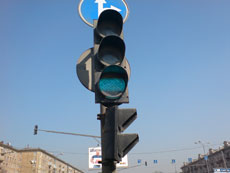 |
(+)
maximize, 2048x1536, JPEG |
(+)
maximize, 2048x1536, JPEG |
 |
 |
(+)
maximize, 2048x1536, JPEG |
(+)
maximize, 2048x1536, JPEG |
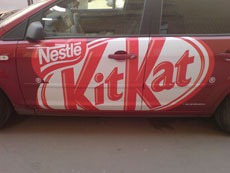 |
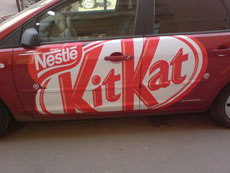 |
(+)
maximize, 2048x1536, JPEG |
(+)
maximize, 2048x1536, JPEG |
 |
 |
(+)
maximize, 2048x1536, JPEG |
(+)
maximize, 2048x1536, JPEG |
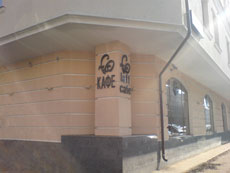 |
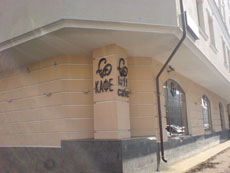 |
(+)
maximize, 2048x1536, JPEG |
(+)
maximize, 2048x1536, JPEG |
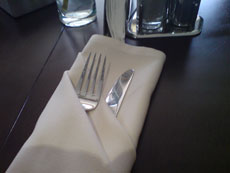 |
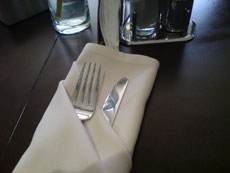 |
(+)
maximize, 2048x1536, JPEG |
(+)
maximize, 2048x1536, JPEG |
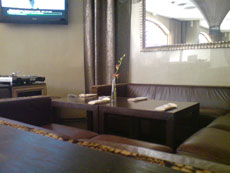 |
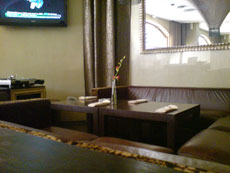 |
(+)
maximize, 2048x1536, JPEG |
(+)
maximize, 2048x1536, JPEG |
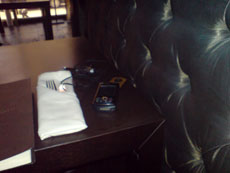 |
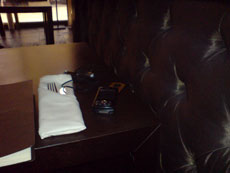 |
(+)
maximize, 2048x1536, JPEG |
(+)
maximize, 2048x1536, JPEG |
 |
 |
(+)
maximize, 2048x1536, JPEG |
(+)
maximize, 2048x1536, JPEG |
 |
 |
(+)
maximize, 2048x1536, JPEG |
(+)
maximize, 2048x1536, JPEG |
 |
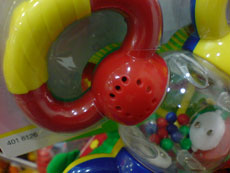 |
(+)
maximize, 2048x1536, JPEG |
(+)
maximize, 2048x1536, JPEG |
 |
 |
(+)
maximize, 2048x1536, JPEG |
(+)
maximize, 2048x1536, JPEG |
 |
 |
(+)
maximize, 2048x1536, JPEG |
(+)
maximize, 2048x1536, JPEG |
 |
 |
(+)
maximize, 2048x1536, JPEG |
(+)
maximize, 2048x1536, JPEG |
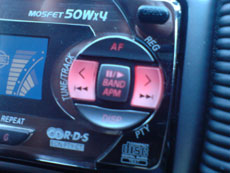 |
 |
(+)
maximize, 2048x1536, JPEG |
(+)
maximize, 2048x1536, JPEG |
You can learn more about camera modes and the ways to handle the K810’s imaging department in a dedicated review.
Video sample (3gp, 456 Kb)>>>
Impressions
Despite the polyphony having 72 chords in the K810i, the handset does not provide a breakthrough in sounding of mp3 tunes compared to other Sony Ericsson branded phones. Volume-wise, performing on average level on this front, the K810i is pretty much akin to Sony Ericsson K790/K800/W810. Be sure you will hear the handset outdoors. The silent alert provides average vibration strength. The reception part is in line with that of other products by the Sony Ericsson – in other words, it’s very fine.
If you come to realize that Sony Ericsson K810i has been launched not as a line-up extender or a replacement for the K800i, but rather as an addition to this model, then all pieces click into place. By the middle of march, when Sony Ericsson K810i is making its debut on the shelves, the original model will have become even more popular, though its design might get somewhat boring, and what is more the new edition is offered at a tad higher price (about 50 Euro on top, a couple of sales package variations will be available). Thinking of the roaring demand for Sony Ericsson K790/K800, we have all the right to expect some good sales from the K810i as well, for it is a fetching solution that still has no competition in its class. Although, Nokia N73 may be counted for one to a certain extent, but at the end of the day, it is backed up with a wholly different philosophy.
Eldar Murtazin (eldar@mobile-review.com)
Translated by Oleg Kononosov (oleg.kononosov@mobile-review.com)
Published — 09 April 2007
Have something to add?! Write us... eldar@mobile-review.com
|
News:
[ 31-07 16:21 ]Sir Jony Ive: Apple Isn't In It For The Money
[ 31-07 13:34 ]Video: Nokia Designer Interviews
[ 31-07 13:10 ]RIM To Layoff 3,000 More Employees
[ 30-07 20:59 ]Video: iPhone 5 Housing Shown Off
[ 30-07 19:12 ]Android Fortunes Decline In U.S.
[ 25-07 16:18 ]Why Apple Is Suing Samsung?
[ 25-07 15:53 ]A Few Choice Quotes About Apple ... By Samsung
[ 23-07 20:25 ]Russian iOS Hacker Calls It A Day
[ 23-07 17:40 ]Video: It's Still Not Out, But Galaxy Note 10.1 Gets An Ad
[ 19-07 19:10 ]Another Loss For Nokia: $1 Billion Down In Q2
[ 19-07 17:22 ]British Judge Orders Apple To Run Ads Saying Samsung Did Not Copy Them
[ 19-07 16:57 ]iPhone 5 To Feature Nano-SIM Cards
[ 18-07 14:20 ]What The iPad Could Have Looked Like ...
[ 18-07 13:25 ]App Store Hack Is Still Going Strong Despite Apple's Best Efforts
[ 13-07 12:34 ]Infographic: The (Hypothetical) Sale Of RIM
[ 13-07 11:10 ]Video: iPhone Hacker Makes In-App Purchases Free
[ 12-07 19:50 ]iPhone 5 Images Leak Again
[ 12-07 17:51 ]Android Takes 50%+ Of U.S. And Europe
[ 11-07 16:02 ]Apple Involved In 60% Of Patent Suits
[ 11-07 13:14 ]Video: Kindle Fire Gets A Jelly Bean
Subscribe
|
